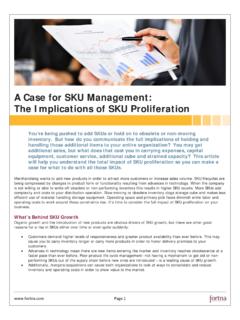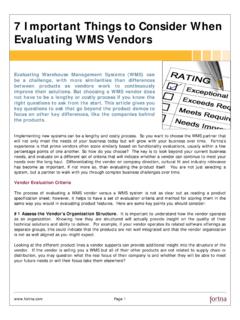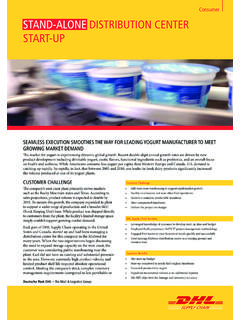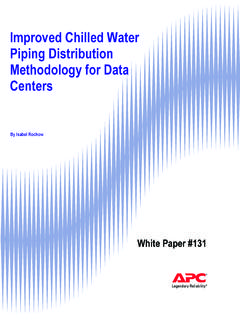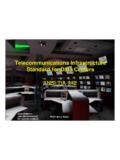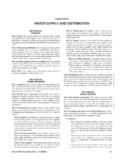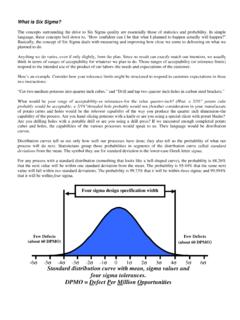Transcription of 11 Key Questions When Adding a Distribution Center
1 Page 1 11 Key Questions when Adding a Distribution Center You ve outgrown your Distribution capacity and need to expand. It may not be as simple as applying your successes from previous Distribution centers to the new one. You ll reap greater rewards if you take a step back and reevaluate your supply chain network and its associated Distribution processes more holistically. Let Requirements Drive Network Strategy Many companies set up their new Distribution Center to mimic their existing ones.
2 However, the requirements that are driving the need to add capacity to your network might dictate a different strategy. For example, you might want to set up new rule sets that assign customer orders to different facilities based on new SKU characteristics, product groups, transportation modes, customer locations and/or inventory availability. Multi-site Distribution environments can be complex. These Questions will help you consider the issues that should be addressed as you expand your Distribution network.
3 question 1: Do supply points need to be changed to service the new DC? Now is the time to reconsider your vendors. Are there new vendors that can provide the same quality products and service, but are located closer to the new facility to reduce transportation costs and transit time? This needs to be considered in all cases, ranging from new ports of entry for international supply or potential freight consolidation locations for domestic supply. Vendor compliance can be a factor as well, with different rules of engagement possible in a multi-facility Distribution network versus a single-facility network.
4 question 2: What will the inventory strategy and deployment rules be? The strategic plan that led to the deployment of a new DC should provide directional guidance around inventory strategy and deployment, but the details must be addressed during facility design. Now you must focus on the requirements for storage and throughput capacity, as well as other upstream and downstream requirements, for example: Types of SKUs that will be handled at each location (break pack, full case, ship-alone large items, hazardous materials, temperature-controlled) Slow-moving SKUs in single or multiple locations Core product deployment versus seasonal product deployment Channel service requirements (Direct, Retail, Wholesale, Multi-channel) 11 Key Questions when Adding a Distribution Center Page 2 question 3: How will product flow from supply points to multiple Distribution centers?
5 Your strategic plan should also provide high-level guidance on this question . But as you consider the implementation of a new Distribution location, more detailed analysis by product type and vendor will need to be conducted. Issues to consider include: Break bulk/freight consolidation centers at ports to deconsolidate or consolidate shipments from overseas or heavy areas of domestic supply Cross-dock capabilities at the new and existing facilities to allow for deconsolidation/transfer operations to be efficient Bypassing internal Distribution altogether and ship some products direct to pool locations, stores, or end-customer locations question 4.
6 Based upon inventory strategy and facility locations, how should the merchandising, procurement, and planning functions operate? A new DC may significantly impact your merchandising and procurement functions. For example, what are your requirements for multiple-destination purchase orders? And what are your optimal SKU ordering characteristics (style/color assortments, prepacks, case quantities)? Other considerations include order frequency and quantity requirements, and adjustment of order lead times to account for landing product supply at multiple destinations.
7 question 5: How will the inbound transportation requirements change? when you split inbound shipments between Distribution facilities, you must understand the impact on vendor order minimums, freight costs and service levels. You will need to establish a rule set for each vendor as part of the systematic management of these requirements. If a core carrier program is in place, it must be determined if it provides the same benefit to the future Distribution network as it does to the existing network.
8 Also, new carriers for the lanes transporting product into the new facility may have to be engaged. question 6: How will inventory allocation between facilities be managed at a tactical level? Allocation timing becomes a key consideration in a multi-site Distribution operation. In most cases, you will want to delay inbound inventory allocation as long as possible. However, the timing of product ownership, inventory visibility and systems must all be considered. question 7: What are the systems requirements necessary to support multi-site transportation, merchandising, purchasing, and allocation requirements?
9 Another consideration when Adding a new Distribution Center is the impact on the systems that manage the product and information flow from buyers and vendors. Inventory management systems, planning and allocation systems, and purchasing systems will have to be modified, or in some instances, replaced. A Distributed Order Management system that allows effective management of multi-site Distribution and allocation requirements is key, as is a transportation management system that provides visibility to the flow of inbound product from vendors to multiple facilities.
10 11 Key Questions when Adding a Distribution Center Page 3 question 8: What SKUs will be rationalized for each facility in the Distribution network? If your goal is to regionalize demand requirements to improve customer service at a lower operating cost, the tradeoff might be increased safety stock inventory investment and costs to carry a full line of SKUs in multiple facilities. Alternatively, you may decide that only fast-moving SKUs or SKUs with certain characteristics or for certain demand channels will be carried in one facility, while others carry the full line of SKUs.




